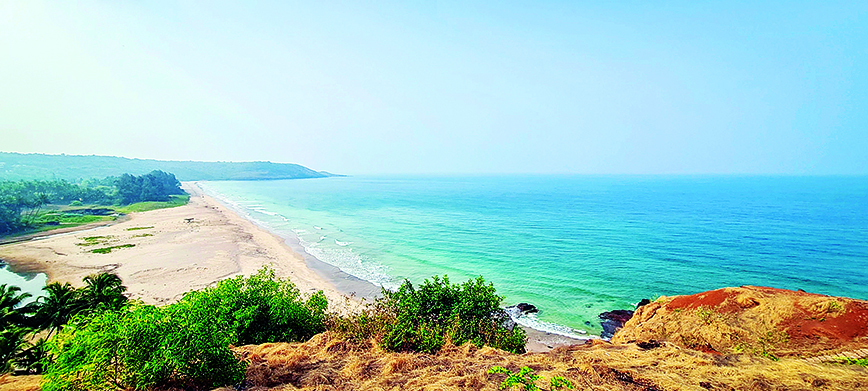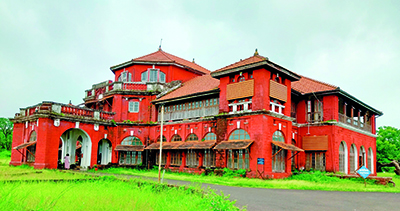
Ratnadurg Fort dominates the landscape
Soaking in the Konkan
Susheela Nair
OUR Konkan sojourn began with Ratnagiri, which conjures up visions of Hapus or Alphonso mangoes. It is said that here you cannot toss a stone without hitting a tree with a ripening Alphonso hanging from a branch.
Ratnagiri has other claims to fame. This erstwhile trading port town is also the birthplace of many distinguished sons-of-the-soil: poets, politicians and revolutionaries. Dr. B.R. Ambedkar, Sachin Tendulkar, and Bal Gangadhar Tilak have their roots here. Ratnagiri is also where dethroned Burmese king Thibaw spent his last years in exile.
The charm of this coastal sojourn is that we seldom lost sight of the deep blue sea, golden sands and acres of emerald foliage. The Konkan coast has something for everyone. Its pristine beaches and ancient temples, vibrant culture and historical legacy, spectacular forts and scenic charm continue to draw beach combers and heritage buffs, adventure junkies and nature enthusiasts, the spiritually inclined and solitude chasers.
The drive up the winding road from Ratnagiri that leads to Ganapatipule is a visual treat all the way with the soaring Western Ghats on one side and the pounding Arabian Sea on the other. On the way we passed Aare Ware Beach, a favourite haunt of visiting film crews.
TEMPLE BY THE SEA
Located at the foot of a hill, the Ganapatipule temple sports beautiful pagoda-style architecture carved out of a single rock. It is a scenic temple, located right on the beach, that has the unending Arabian Sea stretching before it.
The sacred temple and exquisite expanse of water lend a sublime aura to Ganapatipule which is a significant pilgrimage centre for the people of the Konkan coast. I was overwhelmed by the unique ambience, quietude and peace of this temple by the beach.
Legend has it that Lord Ganesha manifested himself on a hillock by the beach, which is why the Ganapati temple was built here. In local parlance, Ganapatipule means pule (sand) blessed by Ganesha.
It is also called Swayambhu Ganapatipule as it is believed that the idea of Lord Ganesha manifested itself at the site, without the intervention of man. We learnt that the residents of Ganapatipule have neither the practice of keeping a Ganesha idol in their homes nor do they do visarjan during the festival. Instead, they worship the idol at the Ganapatipule temple as their own.

PRACHIN KONKAN
From Ganapatipule, we proceeded to Malgund, on the road to Jaigarh. Just a hop, skip and jump away is Prachin Konkan, an open-air museum conceptualized by Vaibhav Vasudev Sardesai, a resident of Ratnagiri. Spread over three acres on a hillside, this beautifully landscaped park offers a fascinating peek into the region’s traditional way of life through life-size models. It is a close-to-realistic sculptural journey into the economy, food habits, cultural traditions, religious events, recreation, and living conditions of the Konkan region in yesteryears.
We came across well-curated village themes depicted beautifully through amazingly crafted life-size sculptures. Sardesai has recreated Konkan’s rural milieu to preserve the pulse of the past. We experienced a slice of rural India and glimpsed models of tailoring shops, grocery stores, barbershops, toymakers, weavers, oilmen, goldsmiths and carpenters.
In addition, there are displays of ancient implements such as an oil press, kitchen tools like a modak cooker and even of Shivaji’s first naval vessel, the Sanghameshwari. We got a peek into the people’s lives, their daily chores, and clothes. For instance, the rural barber visiting doorsteps to offer haircuts, women engaged in household chores, oilmen extracting oil from a mill with an oxen’s help, a goldsmith shaping gold ornaments, carefree children playing traditional games and so on.
The Nakshatra Garden with its 135 trees was equally interesting. After the exertion of the walk, we relished a sumptuous Konkani thali meal comprising solkadi, vegetables and modak (a rice, coconut and jaggery sweet).
KAVI KESHAVSUT SMARAK
Just two km from Ganapatipule, on the road to Jaigarh, we stopped at the memorial to the Marathi poet, Krishnaaji Keshav Damla (Keshavsut). Set up in his house, it has a library as well as an auditorium where poetry sessions are held regularly.
RATNADURG FORT
Sprawling across two hills, the towering Ratnadurg Fort dominates the landscape for miles around. From the top of the fort, there are gorgeous views of a magnificent expanse of blue sea. A fleeting look at the massive ruins was sufficient to get an idea of the grandeur of the fort in its time. It evokes memories of the bygone era of the Bahmani kings, Adil Shah and Chhatrapati Shivaji Rao. Sadly, all that remains today are crumbling walls. Exploring the marvels and mysteries of the fort, we discovered inside the Sri Devi Bhagwati Mandir which gives the fort its other name, Bhagwati Qila.
 THIBAW PALACE
THIBAW PALACE
We culminated our Ratnagiri sojourn with Thibaw Palace which marks the decline of a once incredibly opulent royal family. Perched on a promontory overlooking the sea, the palace today wears a forlorn look in spite of its magnificent exteriors. This is where the dethroned Burmese king spent his last years in exile, gazing at the sea with binoculars. Built under the king’s supervision, at a minimal cost of Rs 1.25 lakh, modest by royal standards, the palace is an amalgamation of Indian, Burmese and colonial architecture with Italian ornamental windows, wooden roofs, and marble dance floors. It was completed in 1910. Currently, it also houses an archaeological museum of antiquities found in the area. Thibaw Point, a short walk from the palace, has a new watchtower from where one gets a bird’s eye view of Ratnagiri.
FACT FILE
Getting there: Ratnagiri is 373 km south of Mumbai. Ganapatipule is 43 km away
What to buy: Alphonso mangoes, cashew, mango milkshake powder, tinned mango pulp, kokum syrup, amla squash, and sundried mango, jamun, and jackfruit pulp
Where to stay: Kohinoor Samudra Resort
Comments
-

Mehreen - Dec. 14, 2023, 10:35 a.m.
I had no idea the Konkan was such a wholesome travel destination! I will be sure to suggest it to family and friends. The pictures are so idyllic, it made me want to catch a flight this instant. I really enjoy your travel pieces.




